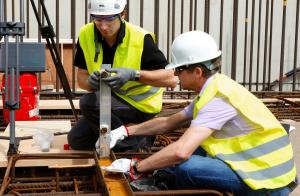Vitally important measurements
On a hot day in July, two surveyors made their way down the metal stairs leading to the Tokamak Complex construction site carrying precision laser measurement equipment.
It was the day before pouring was scheduled for the floor of the drain tank room (part of the Tokamak Building basement, this room will house five large tanks for ITER's cooling water system). In an area adjacent to the northern wall, a survey to control the dimensions had been requested to verify the position and elevation of the 80 embedded steel plates used to anchor the tanks.
It was the first task of a metrology framework contract signed by the ITER Organization in January 2014. Concluded for an initial duration of four years, the contract is extendable up to 10 years to cover later assembly phases. Following a worldwide tender, three consortia were chosen (G2Métric & Arkadia; Metromecánica & Technitop; PES (UK) Ltd & Setis Groupe Degaud); each will compete for specific jobs through Task Requests made by the ITER Organization metrology team.
David Wilson, alignment and metrology responsible officer at ITER, explains: "Controlling the interfaces between the building and the principal Tokamak components is vitally important to ensuring the successful construction of the Tokamak and its associated plant systems. By definition, these 'cast in concrete' items are immovable; therefore, problems will arise if they do not meet the specified tolerances. The philosophy a carpenter goes by—measure twice and cut once—holds true for all metrology activities and supports a rigorous quality regime."
The surveys were carried out over two visits to coincide with the two phases of concrete pouring and were in addition to those carried out independently by the building contractor—providing the vital double check. All of the survey results were communicated to the ITER Buildings & Site Infrastructure team who, together with the European Domestic Agency, were then confidently able to authorize the pouring of the concrete. A repeat survey will be carried out when the concrete is fully set.
The Tokamak Complex will have 83,000 embedded plates on completion; some (3.6 percent) will have very special requirements. Systems such as the cryogenic magnet feeders and the cryostat all have very challenging alignment requirements and, just as for the drain tanks, the accurate position of the steel plates embedded in the building concrete has an important role to play. Many more metrology measurements will be required over the coming years as construction proceeds.
In parallel with civil construction activities, Tokamak components are being manufactured all over the world. These huge items require even more exacting tolerances to be met to ensure that they can be assembled together and function to design parameters. Metrology requirements are currently being assessed with the departments responsible for the design of the Tokamak so as to ensure that resources are available when needed.
"We have now left the design stage and are in construction," says David. "From a metrology perspective this means developing, qualifying and documenting processes for the multitude of systems requiring alignment and dimensional control. Our selected industrial partners will support this evolution and provide the expertise necessary to carry out the metrology tasks."
The need for metrology support will increase exponentially once machine assembly gets underway. Before machine assembly can start, measurements will be taken to accurately determine the as-built 3-dimensional position of each wall, floor and ceiling of the completed Tokamak Building (and all the steel embedded plates) to transform the ideal CAD design into reality. From this survey, the coordinate system to allow machine construction to commence will be established together with associated survey networks to act as reference points during assembly.
Phase one machine assembly is broken down into some 950 construction work packages—it will be up to the ITER metrology team to select the measurements that need to be done and to schedule the metrology tasks.


